|
|
|
|
OLE DEVIL HARDIN SERIES by J.T. Edson
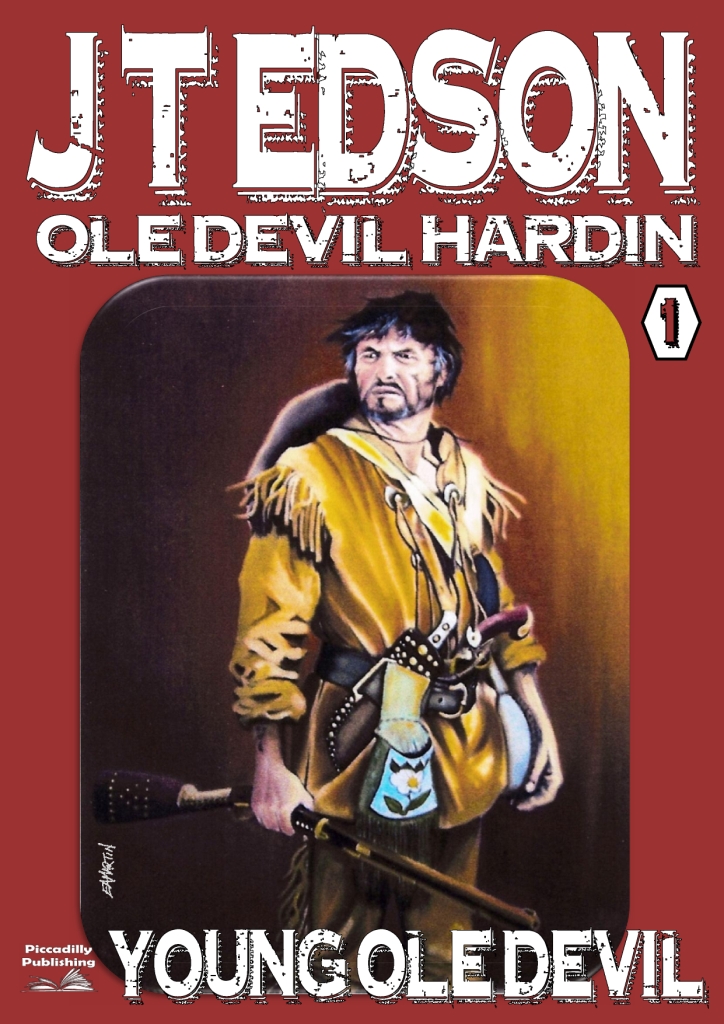 |
| 1: YOUNG OLE DEVIL
"He's reckless, irresponsible and can't–or won't –avoid getting involved in fights no matter what duty he's supposed to be carrying out!" That was the sort of comment which the senior officer of the Texas Light Cavalry might, with some justification, have made about the hot-headed Lieutenant Red Blaze during the War between the States. However, it was uttered by Colonel William Barrett Travis shortly before his departure to take command of the garrison at the Alamo Mission in San Antonio de Bexar early in 1836. He was speaking about a young officer to whom Major General Sam Houston intended to entrust a dangerous mission. The officer in question was to become famous as the iron-hard disciplinarian who commanded the Confederate States Army of Arkansas and Northern Texas. His name was Jackson Baines Hardin.
Published April 01, 2105Recommended Price: $1.99 |
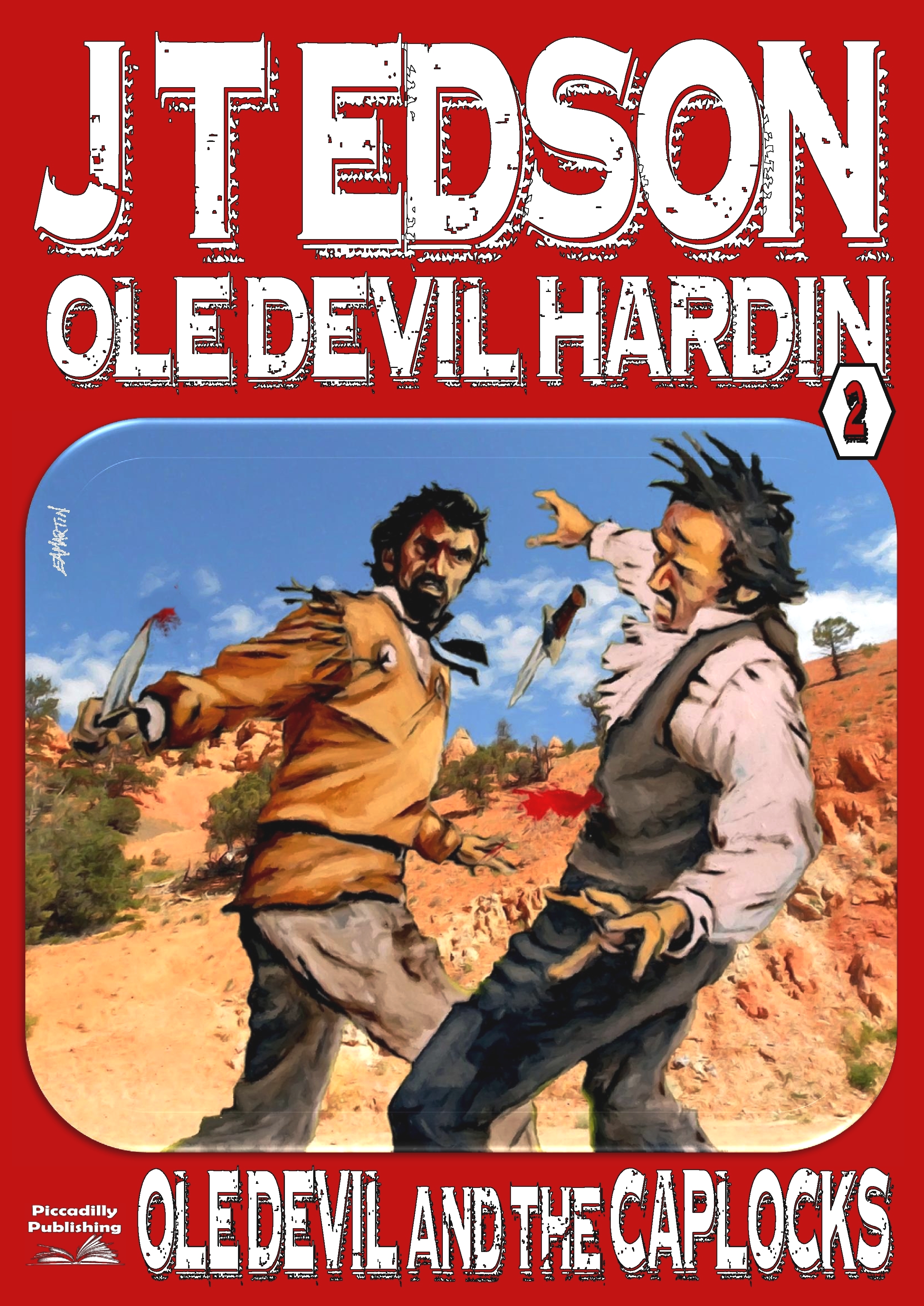 |
| 2: OLE DEVIL AND THE CAPLOCKS
An American shipload of Caplock rifles has been unloaded on the Texas coast. This new-fangled firepower could be vital to the Texians fighting for freedom from Mexico ... if it ever reaches its destination. There's only one man General Sam Houston trusts to escort the Caplock shipment, and that's Jackson Baines Hardin ... the 'Ole Devil' himself.
Ole Devil is a man to be reckoned with, and this time he's got a pistol-packin' girl and a sword-swinging Oriental in his corner. But he hadn't counted on the ornery likes of a vicious Mexican general ... or a townful of cutthroats lusting after the rifles for loot ... or a vengeful woman whose renegade gang would stop at nothing to stop Ole Devil! Published August 01, 2105Recommended Price: $1.99 |
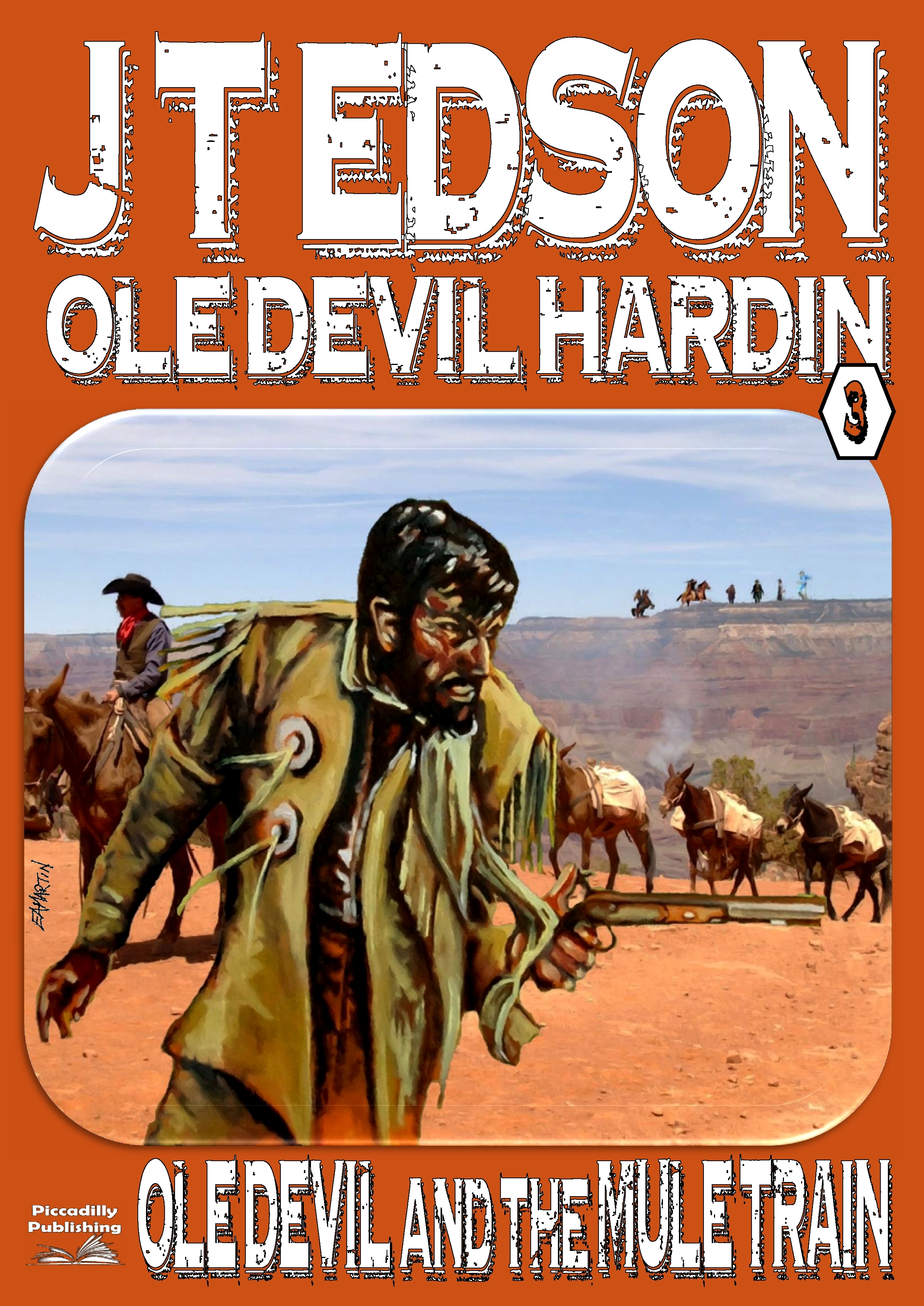 |
| 3: OLE DEVIL AND THE MULE TRAIN
Outnumbered and outgunned, General Sam Houston's dream of a Texas Republic was being shattered by a relentless Mexican army. Houston could still succeed—if Captain Jackson Baines "Ole Devil" Hardin made it to the battlefield with his vital shipment of caplock rifles. But at the banks of the Brazos River, one of Santa Anna's fiercest regiments sprang a cunning attack. Trapped between a raging river and a superior enemy force, the Ole Devil prepared to fight his way to freedom—or die with his gun smoking in his hand.
Published December 01, 2105Recommended Price: $1.99 |
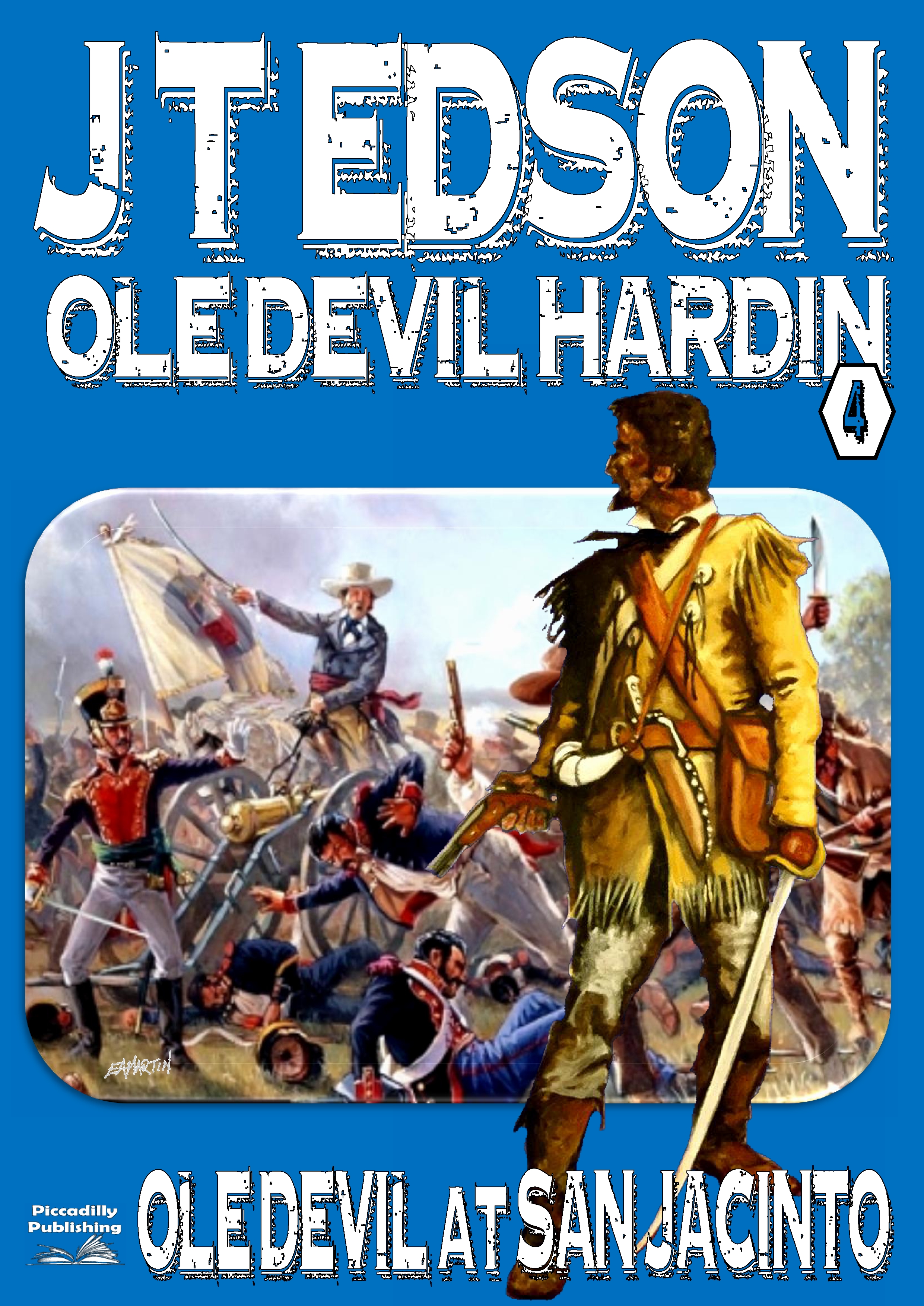 |
| 4: OLE DEVIL AT SAN JACINTO
The Texans' defeat at the Alamo had embittered their bloody rebellion with the gall of revenge. But Major General Sam Houston was determined to meet Santa Anna's superior forces on his own terms. While the Mexican Army–fifteen hundred strong–camped on the banks of the San Jacinto, it fell to three men of the Texas Light Cavalry to even the odds. At their lead was the "Ole Devil" himself, Jackson Baines Hardin. If anybody could pull off a behind-the-lines mission—an impossible victory in their struggle for freedom--he could. Even if it meant dying to do it. Published April 01 2106Recommended Price: $1.99 |
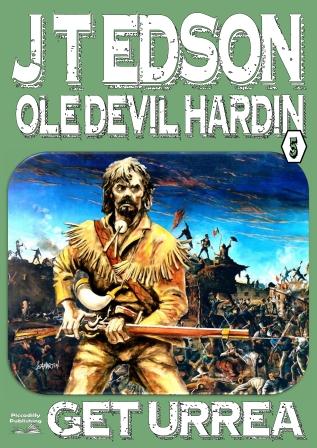 |
| 5: GET URREA!
LAST IN THE SERIES!
It started on a trail north of Goliad. Four hundred Texians were being marched as prisoners by General Jose Urrea's Tamaulipa Brigade. Colonel James W. Fannin had made a deal for his men's lives, but a deal wasn't good enough for Urrea. Suddenly the Texians' captors turned executioners. After a wild melee of men, horses, lances, Baker rifles, dust and blood, General Urrea had his slaughter, and one of the Texians had survived—survived to tell the awful tale to General Sam Houston and Captain Jackson Baines "Ole Devil" Hardin. Now Houston and Ole Devil want revenge. With the war over, they know the only way to get it is to go after Urrea themselves. For Ole Devil, Tommy Okasi and Mannen Blaze, that means donning disguises and riding south into a viper's nest in Mexico--where killing Urrea may be easier than getting out alive.. Published August 01, 2106Recommended Price: $1.99 |
Purchase from these Retailers






Click on the covers for more details or to purchase from Retailers
| ABOUT THE SERIES ...
The series contain the adventures of "Ole Devil" Hardin, Dusty Fog's uncle, a general during the Texan War of Independence (1836). Later, Jackson Baines "Ole Devil" Hardin is the owner of the OD Connected ranch, the ranch for which The Floating Outfit rides. It covers the timespan of 1835-1387.
This explains briefly how the events recorded in YOUNG OLE DEVIL were caused and came about.
Early in February 1836 a Mexican army was marching northwards, its numbers increasing as the Militia of various States and other volunteer regiments were called into service by Presidente Antonio Lopez de Santa Anna. Having consolidated his position as absolute dictatorial ruler of all Mexico south of the Rio Bravo, el Presidente was intending to crush the opposition to his control of Texas.
Neither the Spanish Constitution nor the various regimes which had supplanted it after the formation of the Republic of Mexico in 1822 had ever made a serious effort towards opening up, developing, or even utilizing to any great extent, the vast area of land which they had named "Texas" after the Tejas Indians who had occupied a portion of it. Instead, it had fallen upon foreigners to do so.
Having received a land grant on the Brazos River in 1821, Stephen F. Austin had been encouraged to form a swiftly growing Anglo-U.S. community. Other grants—such as that acquired by the Hardin, Fog and Blaze clan on the Rio Hondo—had been made by the Spanish and earlier Mexican regimes and had allowed the Texians to extend their holdings. By 1830, there were close to fifteen thousand of them living in the hitherto unoccupied and unproductive territory.
Such immigrants had proved to be beneficial to their adopted country. Hard working and industrious for the most part, they had been willing to improve and develop the land which they were occupying. Being capable fighting men, skilled in the use of weapons, they had been able to stand up against the hostile bands of Comanche, Wichita, Tonkawa and Kiowa Indians and, unlike many of the Chicano population, did not expect, or require the protection of the Mexican army against such foes. Furthermore, as they had increased the potential value of their properties, they had formed a useful source of revenue of the Mexican economy.
However, despite all of the financial and other benefits which had accrued from the Anglo-U.S. colonists, the authorities in Mexico City had grown less and less enamored by the prospect of an ever-increasing foreign population, even when it was occupying and making productive land for which they had little use themselves. Diverse languages, customs and, in some cases, religious beliefs had combined with basic differences between the Texians' and the Mexicans' conceptions of democratic government to form constant sources of friction.
The incessant political upheavals, as one unstable regime after another gained power, caused a growing sense of discontent among the Texians. Each successive party to form a government had appeared to be worse than its predecessors. Fully occupied with trying to remain in office, none had given any consideration to the immigrants' request that Texas be established as a separate State—it was regarded as a territory of the State of Coahuila—with representation in the government. They had, nevertheless, continued to levy taxes and duties against the Texians and had attempted to deny entry to further immigrants. As the Texians who had already become established, and not a few of the Chicanos had pointed out, such a prohibition would ruin all hope of further expansion and development.
While the majority of the Texians had accepted Mexican citizenship in good faith, the refusal to grant representation, and other treatment to which they had been subjected by the various regimes caused them to revise their attitudes. More and more of them had come to agree with the faction, amongst which Samuel Houston had been prominent, which had insisted that the only secure future for themselves and their descendants lay in the annexation of Texas by the United States of America.
On coming into power, Santa Anna had quickly shown signs of being more ruthless, vindictive and oppressive than any of his predecessors. Adopting the invariable tactics of every dictator or despotic regime who seeks to impose his, or its, will upon a population, he had decreed that the ownership of firearms was illegal and had sent an order to his brother-in-law, General Martin Perfecto de Cos, that all the Texians were to be disarmed.
Santa Anna's edict regarding firearms proved to be the final straw which had broken the colonists' patience. The Texians had realized that to surrender their weapons would leave them defenseless against the hostile Indians and criminal elements, none of whom would have given up their arms. What was more, it would effectively prevent the immigrants from resisting further impositions by el Presidente.
When the garrisons of the Mexican army—showing an energy which had been noticeably absent when called upon to deal with Indians or bandidos—attempted to carry out the disarmament, the Texians had refused to obey. There had been rioting and open conflict at Anahuac, Gonzales, Velasco and other places. Such had been the fury of the Texians' resistance that most of the Mexican troops had been compelled to fall back and join General Cos at San Antonio de Bexar. Faced with what amounted to an open rebellion by men who still possessed the means to resist and were generally superior to his own soldiers in the handling of weapons, Cos had not been able to enforce el Presidente's wishes. Nor, despite having been aware of the gravity of the situation, had he attempted to have the disarmament edict rescinded or tried to bring about a peaceful settlement.
Realizing that there was no hope of obtaining an. amicable and satisfactory relationship with Santa Anna, the Texians had decided to sever all connections with Mexico. They had set up a provisional government, with Henry Smith and James W. Robinson as Governor and Lieutenant Governor respectively and had sent a commission headed by Stephen F. Austin to the United States to try to obtain arms and provisions. Samuel Houston had been appointed major general and made responsible for organizing an army to defend what would—at least until annexation by the United States, which everybody was confident would be a foregone conclusion, be an independent republic under the Lone Star flag. Prominent and wealthy Texians, such as James Bowie, William Barrett Travis, Edward Burleson, Benjamin Milam, the Fog brothers, Edward and Marsden, James W. Fannin and Frank Johnson, had raised regiments—few of which had a strength exceeding two hundred men—so as to be ready to meet the attempts which all knew Santa Anna would make to subdue their bid for independence.
The earlier stages of the rebellion had been successful as far as the Texians were concerned. Several minor skirmishes had gone in their favor, as had the only major confrontation to have taken place. On December the nth, 1835, after a battle which had lasted for six days, Cos and his force of eleven hundred men had surrendered to Colonels Milam and Burleson at San Antonio de Bexar. Although there had been objections from some of the other senior officers in the Republic of Texas's army, the co-commanders had allowed all of their captives to return unharmed to Mexico on Cos having given his parole that he and his men would not participate in further military action against the Texians. If the reports which had been brought in by the Texians' scouts had been correct, the protest of some officers had been justifiable. Cos was accompanying his brother-in-law and clearly did not intend to honor the conditions of his parole.
While the various successes had boosted the morale of the Republic of Texas's army, they had proved a mixed blessing in that they presented an incorrect impression of the struggle which still lay ahead. The victories, as Houston and most of his senior officers appreciated, had been achieved against poorly trained, badly equipped, and indifferently commanded troops.
Due to Texas being so far from the centre of their country's affairs and offering few opportunities for gaining distinction and promotion, career-conscious officers of good quality had avoided serving there. Houston knew that such men would now be coming and would command battle-tried battalions which had fought in the various struggles between the factions who were attempting to take over the reins of government. They would be a much more dangerous proposition than anything so far faced by the Texians. Not only that, the Mexicans would have a tremendous advantage in numbers.
Being aware of the disparity of the size of his own command and the army which Santa Anna would be able to put into the field, Houston had been disinclined to meet the Mexicans in open battle except upon his own terms and on ground of his choosing. With that in mind, he had ordered all the scattered regiments and people in the western sector to assemble at San Antonio de Bexar. Once they had done so, it was his intention to withdraw into East Texas and make their stand where, if things should go against them, they would have an avenue of escape by crossing the border into the United States.
Although many of the Texians who would be compelled to abandon their homes had seen the wisdom of withdrawing, realizing that el Presidente would show them no mercy if he laid hands on them, not all had done so. Four hundred men, under the command of Colonel Fannin, had declared that they would not retreat and intended to hold the town of Goliad.
There was, however, another and more serious threat to the unity of what remained of Houston's army. Eager for fame, acclaim and glory, Colonel Frank Johnson was planning to invade Mexico along the Gulf Coast route and was willing to go to any lengths to make his scheme succeed. |
|





